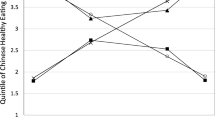Abstract
Objectives
To identify patterns of nutritional risk among older men over a four-year period and to project their survival rates over the next two and a half years.
Design
A prospective longitudinal study.
Setting
Canada.
Participants
Three hundred and thirty-six male survivors of the Manitoba Follow-up Study (MFUS) cohort with an average age of 90 years in 2011.
Measurements
Four years of nutritional risk SCREEN II scores (five waves) from the male survivors of the MFUS cohort. The semi-parametric group-based trajectory approach and survival analysis were used to investigate the trajectories of nutritional risk.
Results
Of the participants, 30% lived alone. Five distinct developmental trajectory groups for nutritional risk score were identified. Significant statistical differences were found among the five trajectory groups for SF-36 mental health (p=.02), SF-36 physical health (p=<.001), perception of aging successfully (p=.04) and living alone (p=<.001). Among the five groups, the most pairwise differences were found in appetite, intake of meat and alternatives, and vegetables and fruit, weight change, skipping meals and eating with others. Men in the poorest nutritional risk trajectory group were two times more likely to die within a 2 1/2 year period compared to men in the best nutritional risk trajectory group (hazard rate = 2.33, p=.07).
Conclusion
Distinct nutritional risk trajectories were found for older men over a four year period. Poor nutritional risk trajectories are associated with higher risk of mortality for very old men over a short period of time. Timely nutritional assessments by health professionals are needed to identify older men at nutritional risk. Subsequent nutrition education and follow-up may be important in preventing further decline.


Similar content being viewed by others
References
Council on Practice (COP) Quality Management Committee. Identifying patients at risk: ADA’s definitions for nutrition screening and nutrition assessment. J Am Diet Assoc 1994;94(8): 838–839.
Keller HH. Promoting food intake in older adults living in the community: a review. Appl Physiol Nutr Metab 2007;32: 991–1000.
Keller HH, Goy R, Kane SL. Validity and reliability of SCREEN II (Seniors in the Community: Risk evaluation for Eating and Nutrition, version II). Eur J Clin Nutr 2005;59(10): 1149–1157.
Ramage-Morin PL, Garriguet D. Nutritional risk among older Canadians. Statistics Canada Catalogue no. 82-003-X. Health Reports 2013;24(3): 3–13.
Milne AC, Potter J, Vivanti A, Avenell A. Protein and energy supplementation in elderly people at risk from malnutrition. Cochrane Database Syst Rev Apr 2009;15(2): CD003288.
Keller HH, McKenzie JD. Nutritional risk in vulnerable community-living seniors. Can J Diet Prac Res 2003;64(4): 195–201.
Broeska VE, Lengyel CO, Tate RB. Nutritional risk and 5-year mortality of older community-dwelling Canadian men: The Manitoba Follow-Up Study. J Nutr Gerontol Geriatr 2013;32: 317–329.
Jung SE, Hermann JR, Bishop A. Impact of nutritional risk on self-care capacity: Social support as a source of protection for community-dwelling older adults living in a rural area. J Frailty & Aging 2013;2(3): 145–149.
Wham CA, Teh ROY, Robinson M, Kerse NM. What is associated with nutrition risk in very old age? J Nutr Health Aging 2011;15(4): 247–251.
Kvamme JM, Gronli O, Florholmen J, Jacobsen BK. Risk of malnutrition is associated with mental health symptoms in community living elderly men and women: the Tromso study. BMC Psychiatry 2001;11:112.
Nykanen I, Lonnroos E, Kautiainen H, Sulkava R, Hartikainen S. Nutritional screening in a population-based cohort of community-dwelling older people. Eur J Pub Health 2013;23(3): 405–409.
Lengyel CO, Tate RB, Bayomi DJ. Nutritional risk of Canadian community-dwelling older men: The Manitoba Follow-up Study. Can J Diet Prac Res 2014;75(1);84–88.
Phillips MB, Foleye AL, Barnard R, Isenring EA, Miller MD. Nutritional screening in community-dwelling older adults: a systematic literature review. Asia Pac J Clin Nutr 2010;19(3): 440–449.
Akhtar U, Keller HH, Tate RB, Lengyel CO. Construct validation of three nutrition questions using health and diet ratings in older Canadian males living in the community. Can J Diet Prac Res Aug 2015;(17):1–6.
Twisk J, Hoekstra T. Classifying developmental trajectories over time should be done with great caution: a comparison between methods. J Clin Epidemiol 2012;65: 1078–1087.
Tate RB, Cuddy TE, Mathewson FAL. Cohort profile: The Manitoba Follow-up Study. Int J Epidemiol 2015;44(5): 1528–1536.
Jones B, Nagin DS, Roeder K. A SAS procedure based on mixture models for estimating developmental trajectories. Sociol Methedol Res 2001;24: 892–901.
Nagin DS. Analyzing developmental trajectories: a semi-parametric, group-based approach. Psychol Methods 1999;4: 139–157.
Nagin DS. Group-based modeling of development. Landon: Harvard University Press,2005.
Kass RE, Raftery AE. Bayes factor. J Am Statist Assoc 1995;90: 773–795.
Ware JE, Sherbourne CD. The MOS 36-item short-form health survey (SF-36). I. Conceptual framework & item selection. Med Care 1992;30(6): 473–483.
Vesnaver E, Keller HH, Payette H, Shatenstein B. Dietary resilience as described by older community-dwelling adults from the NuAge study “If there is a will -there is a way!”. Appetite 2012;58(2): 730–738.
Author information
Authors and Affiliations
Corresponding author
Rights and permissions
About this article
Cite this article
Lengyel, C.O., Jiang, D. & Tate, R.B. Trajectories of nutritional risk: The Manitoba follow-up study. J Nutr Health Aging 21, 604–609 (2017). https://doi.org/10.1007/s12603-016-0826-7
Received:
Accepted:
Published:
Issue Date:
DOI: https://doi.org/10.1007/s12603-016-0826-7




